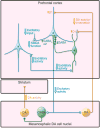How Schizophrenia Develops: Cognitive and Brain Mechanisms Underlying Onset of Psychosis
- PMID: 26493362
- PMCID: PMC4673025
- DOI: 10.1016/j.tics.2015.09.009
How Schizophrenia Develops: Cognitive and Brain Mechanisms Underlying Onset of Psychosis
Abstract
Identifying cognitive and neural mechanisms involved in the development of schizophrenia requires longitudinal observation of individuals prior to onset. Here recent studies of prodromal individuals who progress to full psychosis are briefly reviewed in relation to models of schizophrenia pathophysiology. Together, this body of work suggests that disruption in brain connectivity, driven primarily by a progressive reduction in dendritic spines on cortical pyramidal neurons, may represent a key triggering mechanism. The earliest disruptions appear to be in circuits involved in referencing experiences according to time, place, and agency, which may result in a failure to recognize particular cognitions as self-generated or to constrain interpretations of the meaning of events based on prior experiences, providing the scaffolding for faulty reality testing.
Copyright © 2015 Elsevier Ltd. All rights reserved.
Figures






Similar articles
-
Brain structure in people at ultra-high risk of psychosis, patients with first-episode schizophrenia, and healthy controls: a VBM study.Schizophr Res. 2015 Feb;161(2-3):169-76. doi: 10.1016/j.schres.2014.10.041. Epub 2014 Dec 12. Schizophr Res. 2015. PMID: 25497442
-
[Progress in MRI studies of the schizophrenia spectrum].Seishin Shinkeigaku Zasshi. 2013;115(8):874-9. Seishin Shinkeigaku Zasshi. 2013. PMID: 24167968 Review. Japanese.
-
Hippocampal and amygdala volumes according to psychosis stage and diagnosis: a magnetic resonance imaging study of chronic schizophrenia, first-episode psychosis, and ultra-high-risk individuals.Arch Gen Psychiatry. 2006 Feb;63(2):139-49. doi: 10.1001/archpsyc.63.2.139. Arch Gen Psychiatry. 2006. PMID: 16461856
-
Altered Thalamo-Cortical White Matter Connectivity: Probabilistic Tractography Study in Clinical-High Risk for Psychosis and First-Episode Psychosis.Schizophr Bull. 2016 May;42(3):723-31. doi: 10.1093/schbul/sbv169. Epub 2015 Nov 23. Schizophr Bull. 2016. PMID: 26598740 Free PMC article.
-
Neuroimaging and emerging psychotic disorders: the Melbourne ultra-high risk studies.Int Rev Psychiatry. 2007 Aug;19(4):371-81. doi: 10.1080/09540260701512079. Int Rev Psychiatry. 2007. PMID: 17671870 Review.
Cited by
-
Investigating the Impacts of Diet, Supplementation, Microbiota, Gut-Brain Axis on Schizophrenia: A Narrative Review.Nutrients. 2024 Jul 11;16(14):2228. doi: 10.3390/nu16142228. Nutrients. 2024. PMID: 39064675 Free PMC article. Review.
-
State-Dependent Functional Dysconnectivity in Youth With Psychosis Spectrum Symptoms.Schizophr Bull. 2020 Feb 26;46(2):408-421. doi: 10.1093/schbul/sbz052. Schizophr Bull. 2020. PMID: 31219595 Free PMC article.
-
Contribution of Pro-Inflammatory Molecules Induced by Respiratory Virus Infections to Neurological Disorders.Pharmaceuticals (Basel). 2021 Apr 8;14(4):340. doi: 10.3390/ph14040340. Pharmaceuticals (Basel). 2021. PMID: 33917837 Free PMC article. Review.
-
Integration of structural brain networks is related to openness to experience: A diffusion MRI study with CSD-based tractography.Front Neurosci. 2022 Dec 8;16:1040799. doi: 10.3389/fnins.2022.1040799. eCollection 2022. Front Neurosci. 2022. PMID: 36570828 Free PMC article.
-
Etiopathogenic Models of Psychosis Spectrum Illnesses Must Resolve Four Key Features.Biol Psychiatry. 2022 Sep 15;92(6):514-522. doi: 10.1016/j.biopsych.2022.06.024. Epub 2022 Jun 25. Biol Psychiatry. 2022. PMID: 35931575 Free PMC article. Review.
References
Publication types
MeSH terms
Grants and funding
LinkOut - more resources
Full Text Sources
Other Literature Sources
Medical

